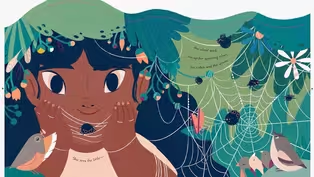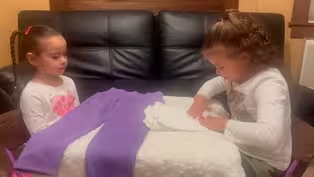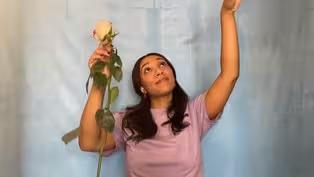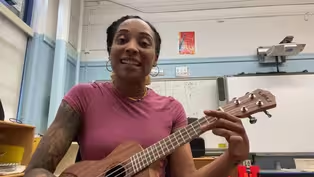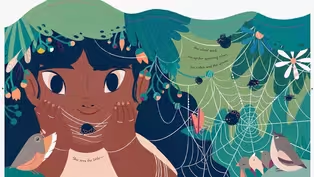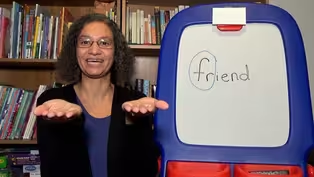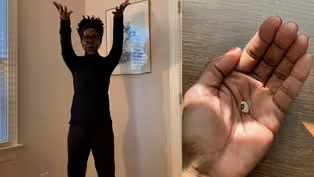
WHY ANIMALS NEED PLANTS
Clip: 4/20/2023 | 8m 43sVideo has Audio Description, Closed Captions
Chelsea Rim from the Memphis Zoo explains why animals need plants.
Chelsea Rim from the Memphis Zoo explains how plants provide food and shelter for animals and humans.
See all videos with Audio DescriptionADProblems playing video? | Closed Captioning Feedback
Problems playing video? | Closed Captioning Feedback
Let's Learn is a local public television program presented by THIRTEEN PBS

WHY ANIMALS NEED PLANTS
Clip: 4/20/2023 | 8m 43sVideo has Audio Description, Closed Captions
Chelsea Rim from the Memphis Zoo explains how plants provide food and shelter for animals and humans.
See all videos with Audio DescriptionADProblems playing video? | Closed Captioning Feedback
How to Watch Let's Learn
Let's Learn is available to stream on pbs.org and the free PBS App, available on iPhone, Apple TV, Android TV, Android smartphones, Amazon Fire TV, Amazon Fire Tablet, Roku, Samsung Smart TV, and Vizio.
Providing Support for PBS.org
Learn Moreabout PBS online sponsorship[lively music] - Hi friends.
My name is Chelsea and I'm an animal interpreter at the Memphis Zoo in Memphis, Tennessee.
Here at the zoo, I get to take care of some incredible animals and share some of the things that I'm passionate about with friends like you.
Today, we're going to explore one of my favorite topics, plants.
As a zookeeper, I talk a lot about animals, but it's just as important to me that I tell the stories of plants too.
They can live in a wide variety of conditions, respond to their environment by altering the way that they grow and even have special methods for communicating with other plants and animals.
Plants are an essential part of life on earth.
Plants provide people with food, shelter, clothes, medicine and even the oxygen that we breathe.
But you and I are not the only ones that rely on plants.
Animals also need plants to survive and thrive.
Let's learn about the remarkable ways in which animals and plants help each other and in doing so, learn how we can help plants too.
The lives of plants and animals are intricately woven together.
Plants are impacting animals in countless ways all the time.
But the two most fundamental services that plants provide to animals are food and shelter.
Food provides the energy that living things need to operate, and plants are a crucial food source in the animal world.
Herbivores are animals that only eat plant matter.
Deer, elephants and gorillas are all herbivores.
Herbivores can eat grasses, leaves and even wood.
Some herbivores only can consume specific parts of plants like frugivores.
Frugivores are animals that primarily eat fruit.
Like Lilo, the keel-billed toucan.
Lilo gets a wide variety of fruits every single day.
If you asked her to imagine a world without plants, she'd say no way.
Other herbivores are specialists, meaning they have adapted to eating one specific plant.
The koala in Australia only eats the leaves of the eucalyptus tree and the giant panda of Asia feeds strictly on bamboo.
Plants also provide animals less shelter.
A shelter can be a place of security where animals find protection from predators, a place to find or store food, a place to raise their young, a place to sleep, or even just a place to rest.
Plants like trees often make great homes for animals.
Our boreal animals are animals that spend most their time in trees, finding shelter and hollow cavities that are up high in the branches.
Check out this monkey, our boreal animal enjoying the shelter of a tree, being able to retreat into trees keeps our boreal animals safe from predators on the ground that might not be able to reach them.
It also makes it easier for them to watch for danger from a high vantage point, this is perfect for animals like birds who use trees as shelter to build nests for their babies.
The babies will stay up in those nests until they're big and strong enough to take care of themselves.
Plants like tall grasses provide shelter in the form of cover for animals hoping to stay hidden from predators.
Although these tall grasses may also help predators stay hidden while hunted.
The stripes on a tiger's fur for example, are specially adapted to help tigers blend into the tall grass in which they live.
Kelp forests underwater provide the structure for a balanced and flourishing ecosystem where many animals can find shelter and a home.
Wow, plants help animals in so many different ways, but don't you worry, animals do their fair share of helping too.
Animals and plants help each other out through mutualistic relationships.
A mutualistic relationship is a special partnership between two species in which both benefit from one another.
Let's explore how animals help plants through some of these unique partnerships.
First, animals help plants with pollination.
In order for many plants to reproduce and make more plants, they must undergo pollination.
Animals like these butterflies and hummingbirds are crucial for helping plants pollinate.
These animals enjoy drinking the yummy nectar from flowers.
And when they stop to get a drink, the sticky pollen from the flower will get stuck to their leg or another body part.
The pollen will hitch a ride on that animal until it is brought to the animal's next nectar stop where the pollen will fall off and fertilize that plant.
The animal gets a meal and the plant gets to reproduce.
Both parties benefit.
Plants have adapted methods to attract more pollinators to them, such as sporting bright, beautiful flowers.
This is enticing to animals like bees that are drawn to bright colors.
Some plants may emit a special smell to attract their preferred pollinator, or they may even have certain barriers to deter the unpreferred pollinators.
Not all pollinators in the animal kingdom fly.
The Madagascar hissing cockroach like Buddy here is one of my favorite pollinators to talk about.
These friends are native to Madagascar, an island off the coast of Africa, and they are an important pollinator for the cacao plant, which is responsible for producing chocolate.
I don't know about y'all at home, but I love chocolate.
And in addition to chocolate, there are many foods that the world wouldn't have without successful pollination, including fruits, vegetables, and nuts.
So we have a lot of gratitude to express to Buddy and his pollinating friends.
Second, animals help plants with seed dispersal.
Like pollination, seed dispersal is a crucial process for the growth of new plants.
Seed dispersal occurs when the seeds of a plant travel away from it and settle somewhere where they can grow into a new adult plant.
Wind, water and even humans can help seeds disperse, but animals are a huge help.
Animals disperse seeds in two main ways, excretion and burying.
Let's talk about excretion.
When an animal eats fruit, it usually consumes the seeds as well.
Well, when that animal travels to another place, the seeds they ate are also expelled or excreted by hitching a ride in the animal's poop, the seeds will hopefully take well to the new location they've been dropped in and grow into adult plants.
Animals don't only use the power of poop to disperse seeds though, they can bury them.
Squirrels like [indistinct] the Western Gray Squirrel love eating nuts and seeds.
Squirrels often like to store some of the nuts they collect so they can come back to them later and eat them.
They do this by burying them in the ground.
Pat, pat, pat, all hidden and covered.
Well, it's pretty common for the squirrels to forget where they buried some of these nuts.
And so the nuts that the squirrels have planted and forgotten about may grow to become adult plants.
Kind of like little gardeners.
Who knew animals help plants in so many ways, but you might be wondering, how could we help plants?
We can create mutualistic relationships with plants too.
Let's look at three main ways that we can help.
The first thing that we can do to help plants is to use less paper products.
We can use towels instead of paper towels.
Reuse paper for fun crafts and use both sides of a sheet of paper when we're writing, or if possible, opt for a digital option like a computer or a laptop.
The less paper that we use, the less trees that have to be cut down to make paper products.
The second way that we can help plants is by being kind to them.
Plants are incredibly in tune with their environment and the stimulus around them.
Knowing this, we can take extra care to give plants their space and be respectful.
Observing the beauty of flowers instead of plucking them from the ground and staying on designated pathways when possible to avoid stepping on fragile plants that may be nearby.
Continuing to learn about plants gives us knowledge and knowledge gives us the power to ensure that we do our part and making earth a place where plants can thrive.
All right, friends, how about we review what we learned?
First, we learned how plants help animals with food and shelter.
Then we learned how animals help plants with pollination, seed dispersal and protection.
And finally, we learned how we can help plants by doing things like using fewer paper products and giving plants their space.
Now, I want you to close your eyes and imagine all the things in your life that you could thank a plant for.
Now, open your eyes.
It's a lot, right?
Well, now you know how to thank them.
Friends, I hate to have to leaf, but it's time for me to give back to the animals.
Thank you so much for exploring the world of plants with me.
And on behalf of myself and the rest of us here at the Memphis Zoo, may you continue learning and making a difference.
I'm rooting for you.
Okay, last one, I promise.
Bye, friends.
Video has Audio Description, Closed Captions
Clip: 6/12/2023 | 7m 47s | Carlton Ellen reads MY FRIEND EARTH by Patricia MacLaughlin. (7m 47s)
Video has Audio Description, Closed Captions
Clip: 4/20/2023 | 37s | Bella and Lulu fold clothes. (37s)
Video has Audio Description, Closed Captions
Clip: 4/20/2023 | 8m 56s | Caitlyn McCain from the NYC Children’s Theater prompts children to feel like flowers. (8m 56s)
Video has Audio Description, Closed Captions
Clip: 4/20/2023 | 9m 45s | Arielle Lewis from Education Through Music explores the terms crescendo and decrescendo. (9m 45s)
Video has Audio Description, Closed Captions
Clip: 4/20/2023 | 7m 47s | Carlton Ellen reads MY FRIEND EARTH by Patricia MacLaughlin. (7m 47s)
Video has Audio Description, Closed Captions
Clip: 4/20/2023 | 10m 44s | Anna Scretching-Cole helps children learn about s and r blends. (10m 44s)
Video has Audio Description, Closed Captions
Clip: 4/20/2023 | 5m 57s | Eve Townsend counts, measures, and sings while caring for a plant. (5m 57s)
Providing Support for PBS.org
Learn Moreabout PBS online sponsorshipSupport for PBS provided by:
Let's Learn is a local public television program presented by THIRTEEN PBS
